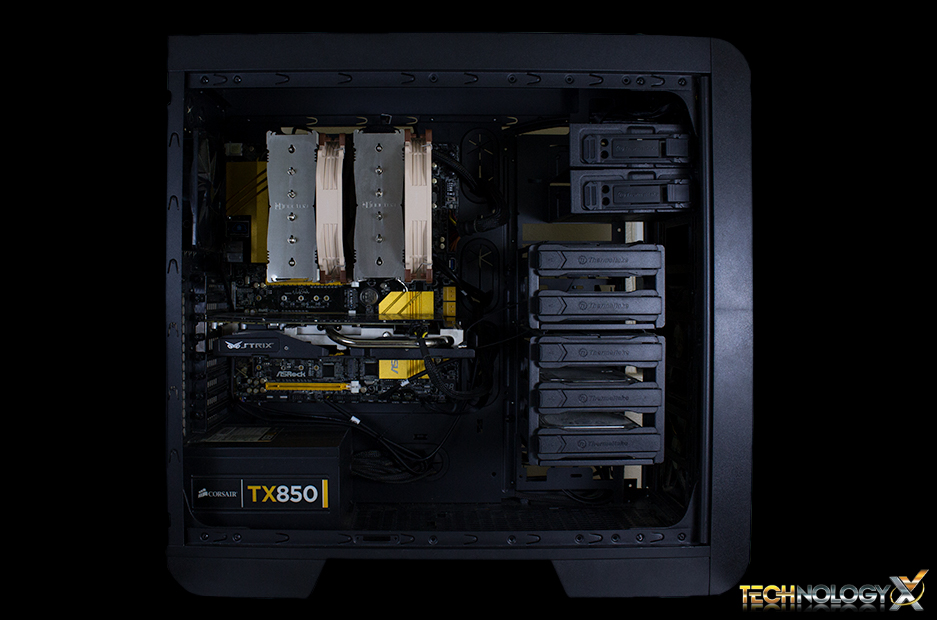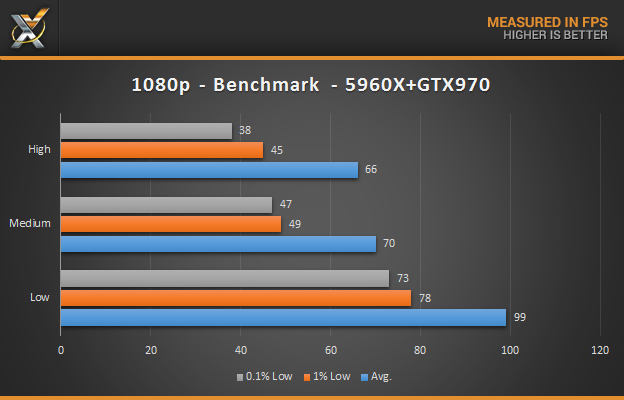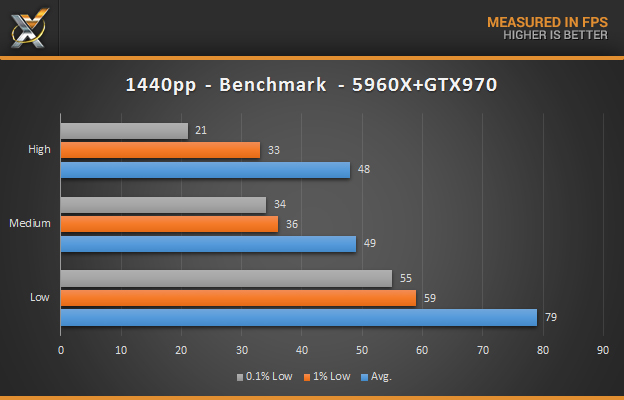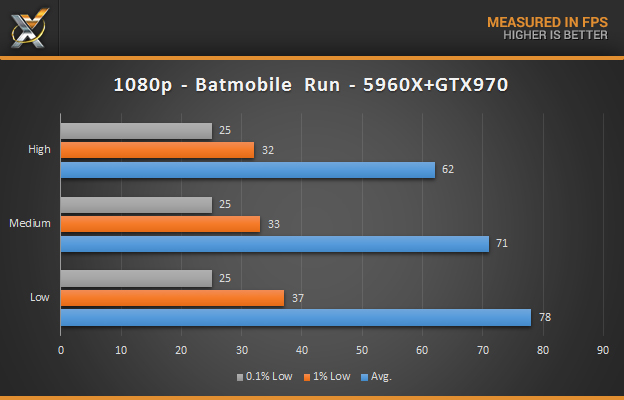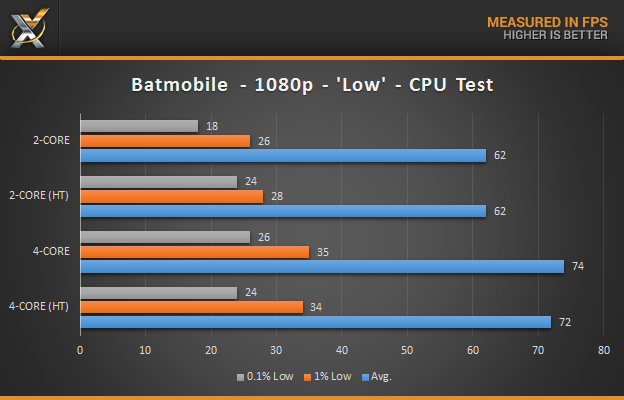We test the game at several graphical presets which include ‘High’, ‘Medium’ and ‘Low’ and at resolutions of both 1080p, and 1440p. All tests were done at Fullscreen, with Anti-Aliasing (FXAA) enabled, and V-Sync turned off. We also modified the game’s INI files in order to unlock the 30FPS software cap.
High: Texture Quality: ‘Normal’, Shadow Quality: ‘High’, Level of Detail: ‘High’. All GameWorks settings are enabled.
Medium: Texture Quality: ‘Low’, Shadow Quality: ‘Normal’, Level of Detail: ‘Normal’. All GameWorks settings are enabled.
Low: Texture Quality: ‘Low’, Shadow Quality: ‘Low’, Level of Detail: ‘Low’. All GameWorks settings are disabled.
Performance was first tested using the in-game benchmark utility. FPS was recorded using FRAPS, and then analysed using FRAFS. We then used FRAPS to record an in-game, real-world run in the Batmobile in order to quantify the type of performance users can actually expect when playing the game, as we found the in-game benchmark to be an inaccurate representation of the game’s current state.
TECHNOLOGY X TEST BENCH
All of the components we use for testing are standard off-the-shelf PC components from major manufacturers, which can be purchased at a variety local retailers and online. We’ll also provide links to our components for those of you that find an interest in our equipment.
We’d like to thank Intel, ASRock, and Crucial for providing vital components in this test bench, without which this report would not be possible. Check out our review of the Intel Core i7 5960X, ASRock X99 OC Formula, and the Crucial Ballistix Elite DDR4-2666 memory kit, used in this report.
For the purposes of this test, we also overclocked our ASUS STRIX GTX 970 to an easily achievable 1400MHz on the GPU clock, and 7400MHz on the memory clock.
| PC CHASSIS: | Thermaltake Core V51 |
| MOTHERBOARD: | ASRock X99 OC Formula |
| CPU: | Intel Core i7 5960X @ 4.2GHZ OC |
| MEMORY: | 16GB Crucial Ballistix Elite DDR4-2666 |
| CPU COOLER: | Noctua NH-D15 |
| POWER SUPPLY: | Corsair TX850 v2 |
| GRAPHICS CARD: | ASUS STRIX GTX 970 OC |
| STORAGE: | ADATA 1TB Premiere Pro SSD |
BENCHMARKS
In order to accurately measure the gaming experience, we decided to forgo the use of minimum and maximum FPS in our results. This is because these values do not accurately represent the actual experience, or ‘smoothness’ of the game’s performance. Instead, we’ll be using the average FPS, as well as the average of the lowest 1%, and 0.1% of results . We believe these results will better showcase the variance in performance.
BUILT-IN BENCHMARK UTILITY
So, as we can see; if we only used the game’s built-in benchmark utility as an example, then it would appear that the game is quite playable on our test bench, with all of the 1080p results quite smooth with average frame-rates well above 60 FPS and minimal frame-time variance. Even at 1440p, the game is still quite playable, with relatively smooth performance at all but the highest settings. Unfortunately though, this is not the whole story.
REAL-WORLD PERFORMANCE (BATMOBILE)
Once we run our real-world performance test using the Batmobile, which seems to be the game’s most demanding portion, we start to see what users can actually expect when running the game. Note that our average FPS still stays well above 60 FPS in at all settings, however our frame-time variance drops enormously into the high 30s and mid 20s, resulting in severe stutter, and huge spikes which can render the game unplayable.
CPU MULTI-CORE SCALING
To further test the performance of the game, we decided to re-run our Batmobile test on ‘Low’ settings, and use our Core i7 5960X to simulate other common CPU configurations by disabling cores or hyper-threading to match other SKUs. We left our CPU frequency untouched with our 4.2GHz overclock in order to keep differences to only core count and hyper-threading.
Taking a look at the above results, it seems the game does utilize up to four threads, as our native quad-core seems to fair the best, whereas the quad-core with hyper-threading loses a bit, likely due to hyper-threading being enabled. It seems the dual-core and dual-core with hyper-threading perform about the same as well, with the latter fairing a bit better in frame-time variance. Unfortunately, with the game in such a poor performing state, it is difficult to really quantify performance across multiple CPU configurations. This is something we hope to revisit in future articles, after the game has been patched.
REPORT ANALYSIS AND FINAL THOUGHTS
It has been a really odd couple of years for PC games. With 2014’s Watch_Dogs and Assassin’s Creed Unity launching with lots of performance issues, and graphical downgrades, and games like The Witcher 3 launching with poor performance on AMD hardware, and now Batman Arkham Knight launching in such a poor state that its publisher was forced to suspend sales of the game on PC. You’d think that with current-generation consoles, and PCs sharing an architecture, and with robust engines like Unreal Engine 4, Frostbite 3 and CryEngine making it easier to develop for all three platforms at once, that games would launch with more polish and you know, actually be playable.
Unfortunately, it seems that as long as publishers, and studios refuse to allocate proper resources to PC versions of AAA titles, we’re going to see quite a bit more instances like this in 2015, and probably even beyond that. In any case, here’s hoping the industry can sort out these systemic issues before Half-Life 3 releases.
 Technology X Tomorrow's Technology Today!
Technology X Tomorrow's Technology Today!

